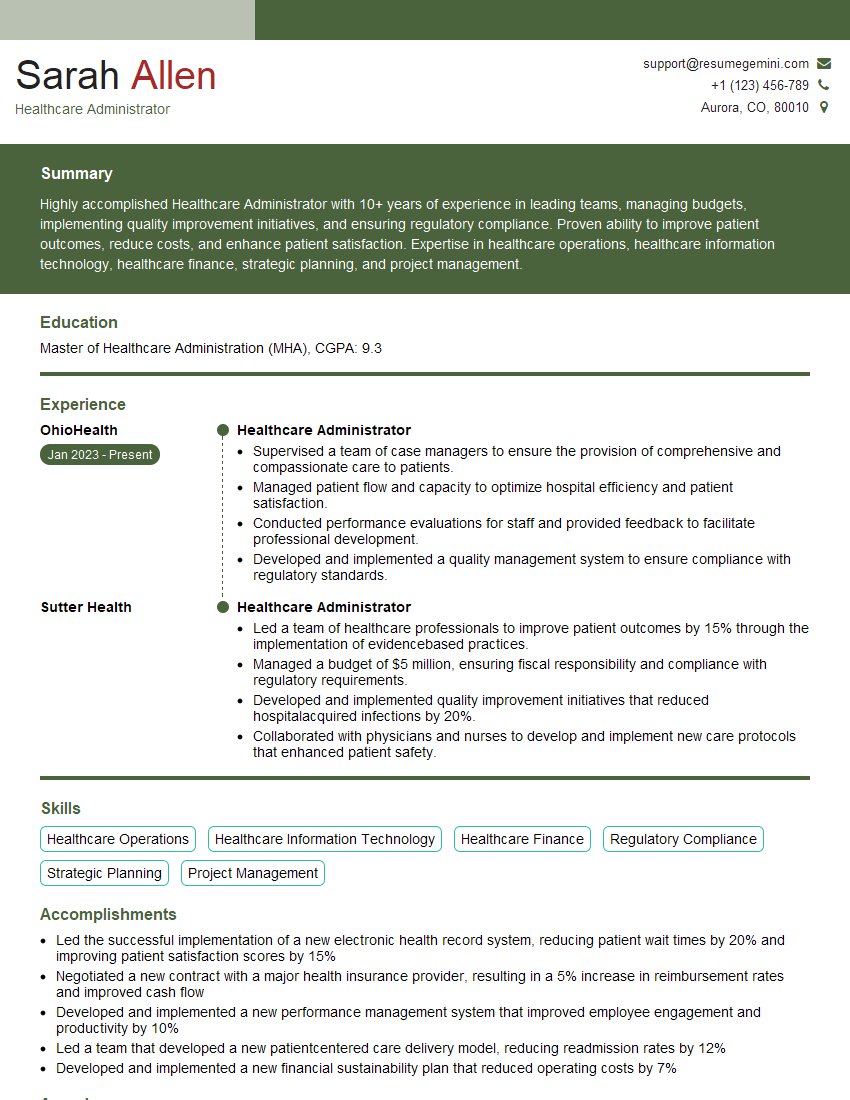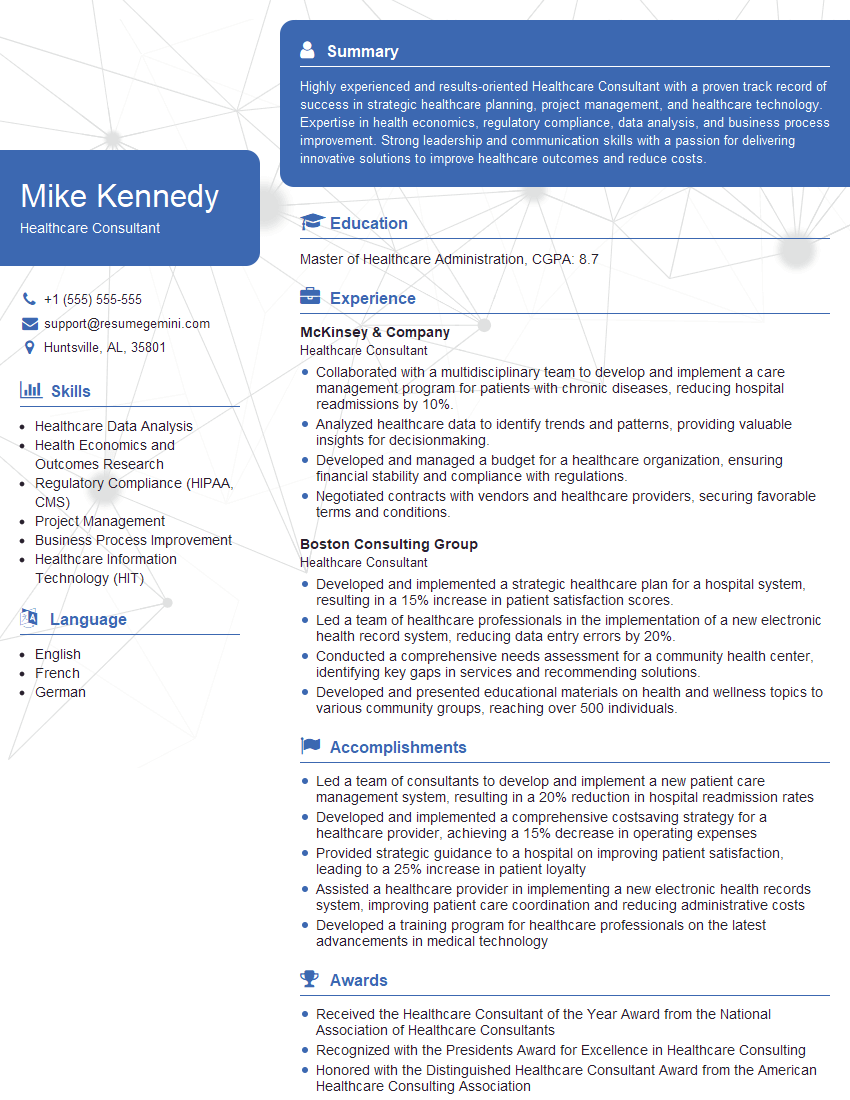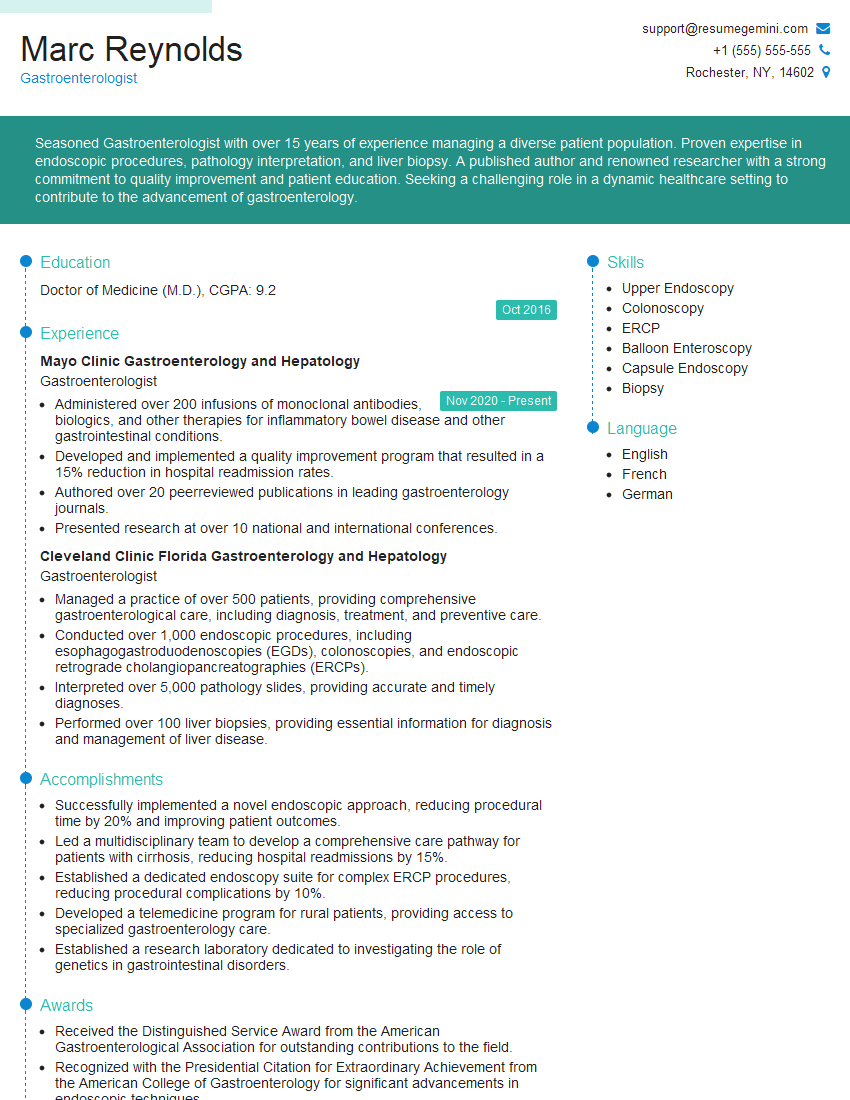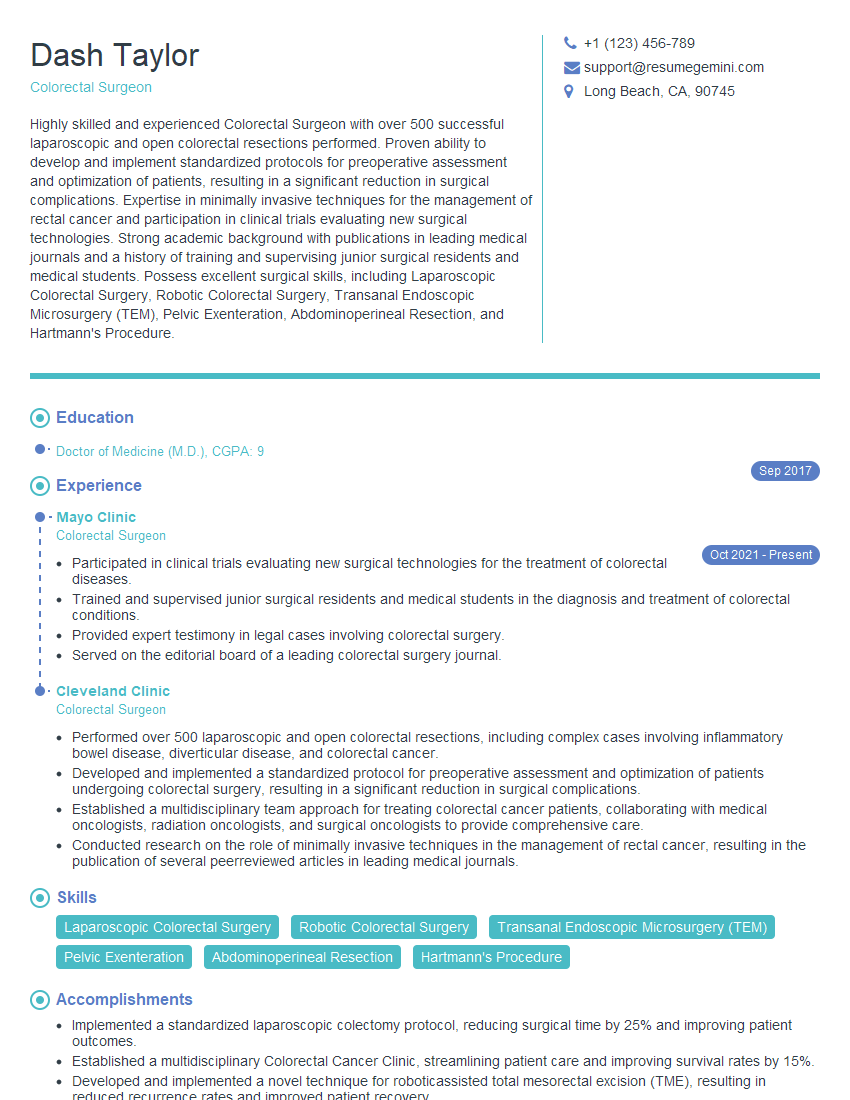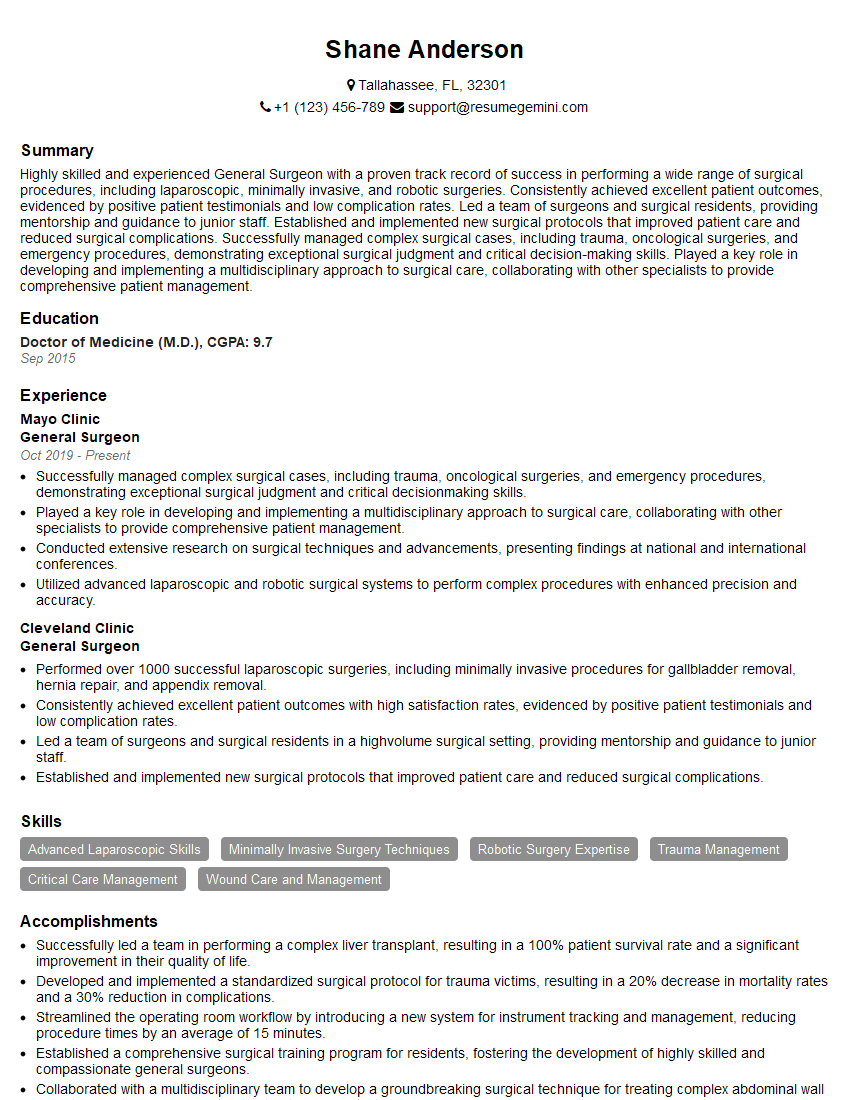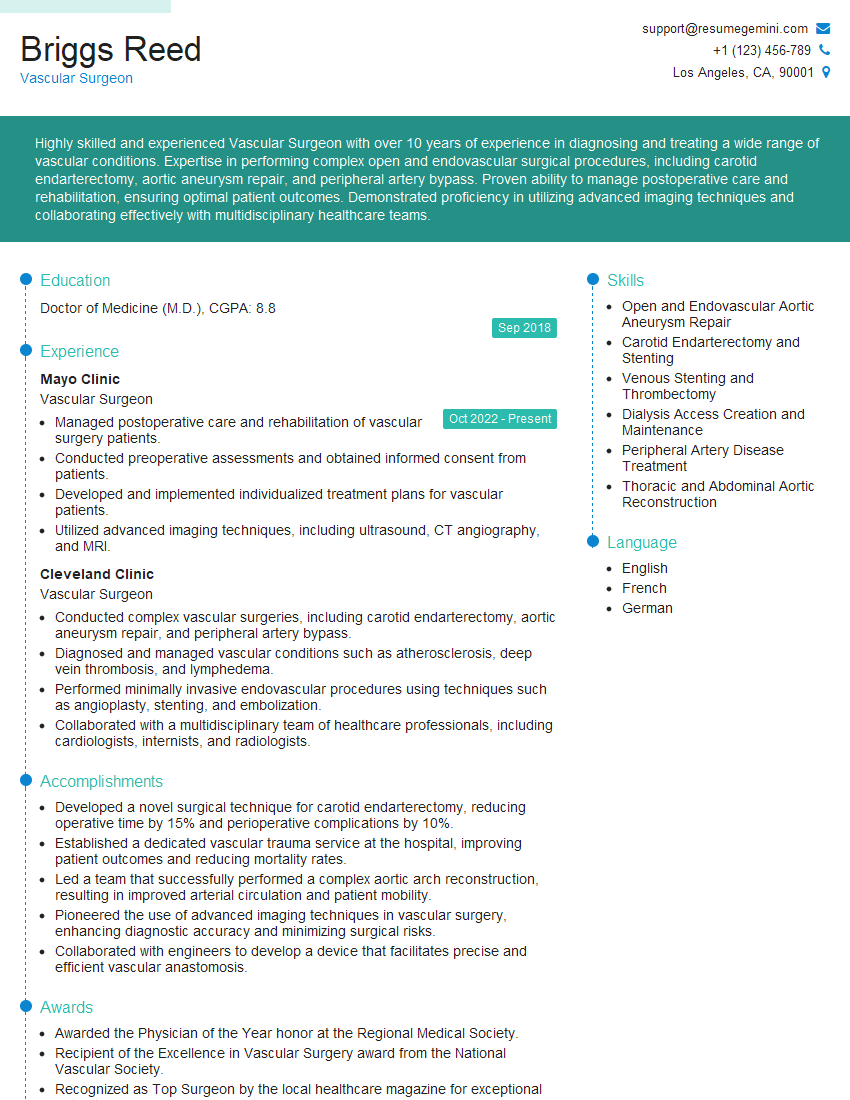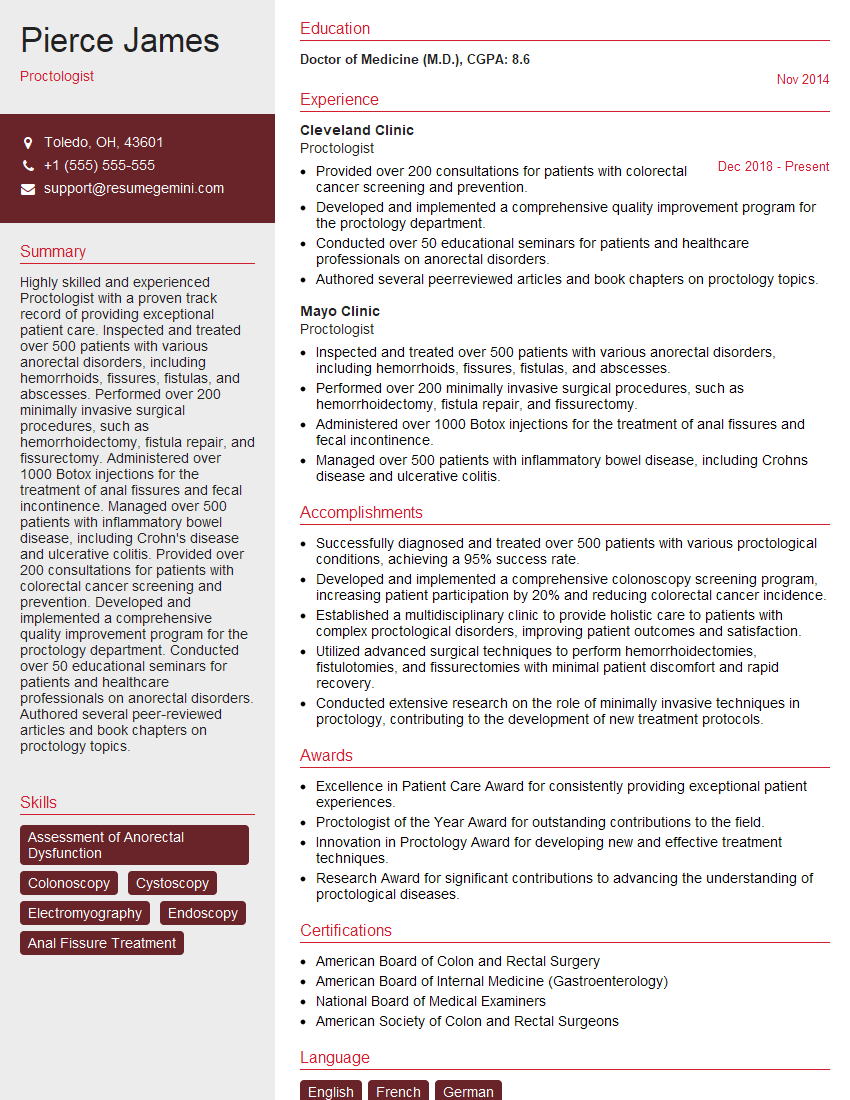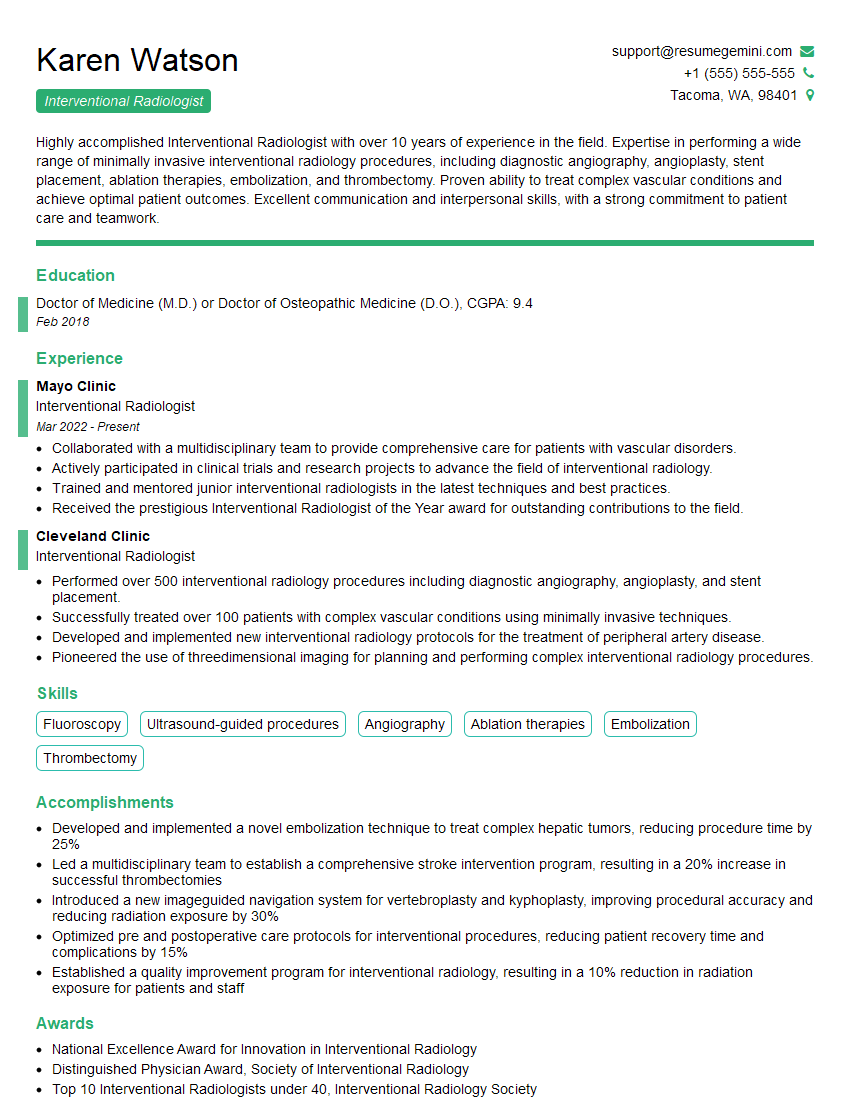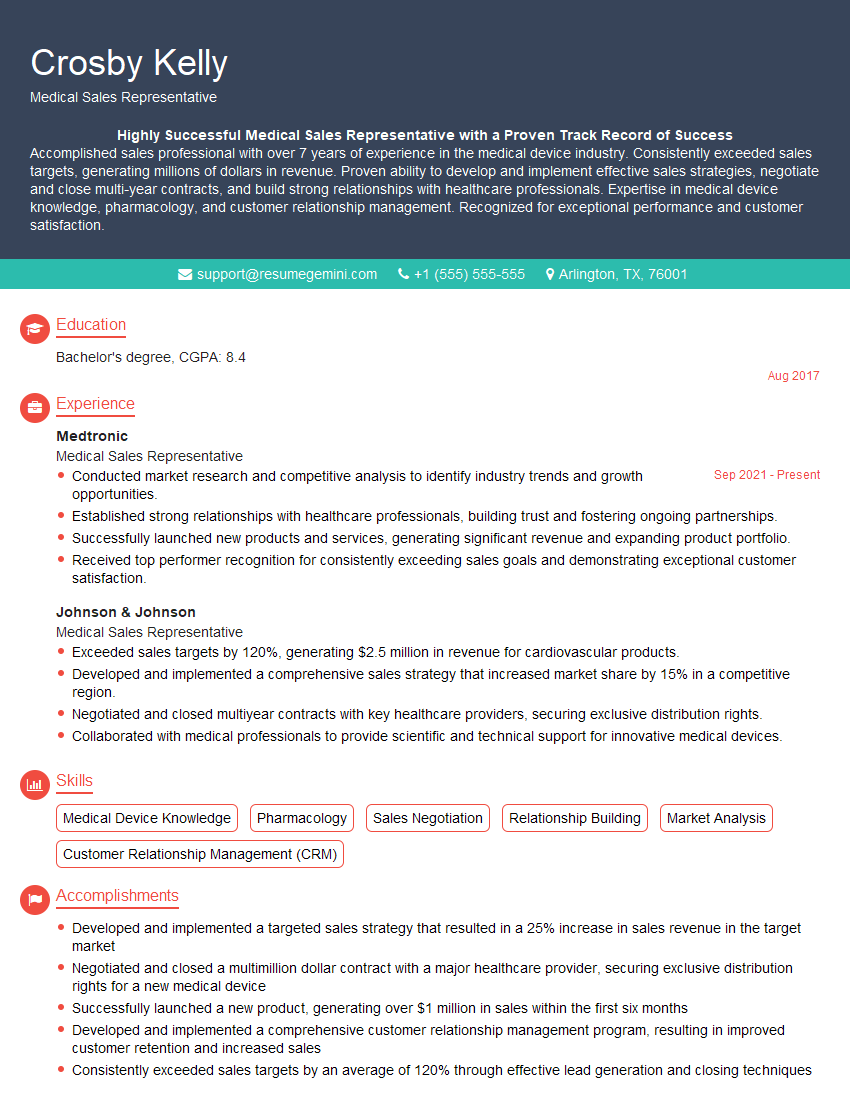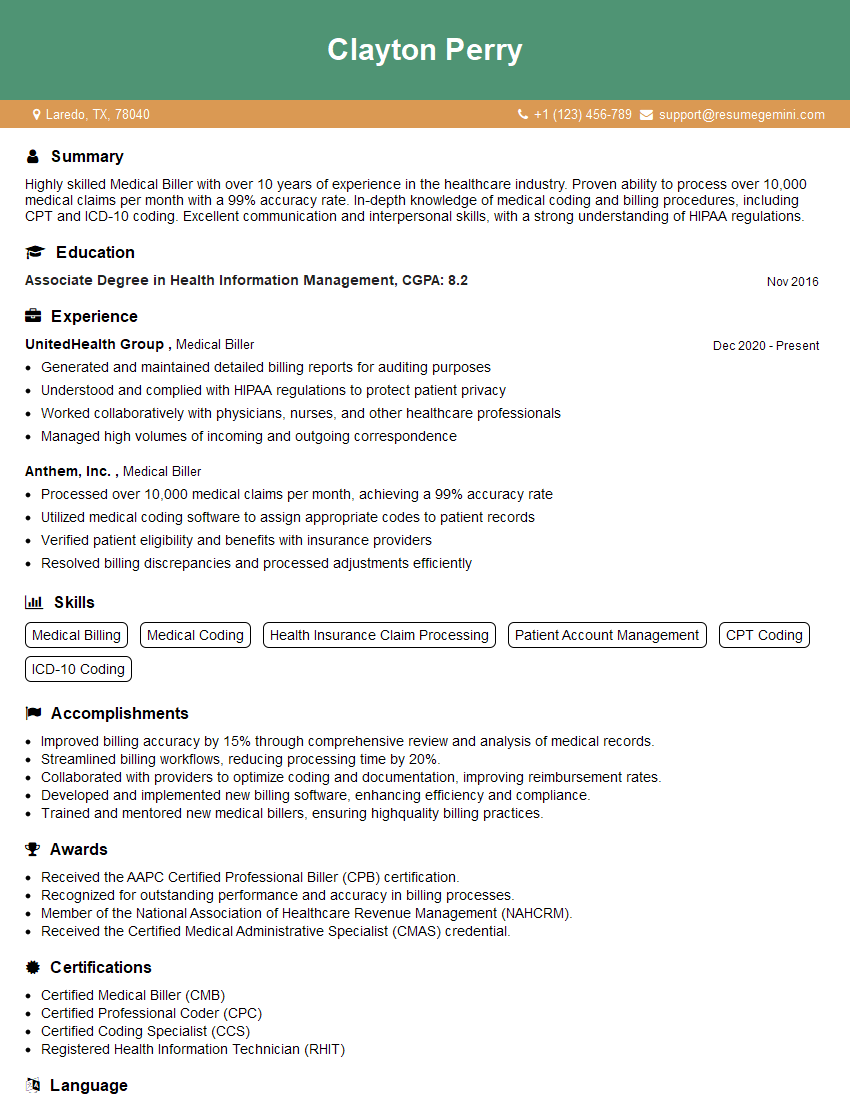Cracking a skill-specific interview, like one for Sclerotherapy for Hemorrhoids, requires understanding the nuances of the role. In this blog, we present the questions you’re most likely to encounter, along with insights into how to answer them effectively. Let’s ensure you’re ready to make a strong impression.
Questions Asked in Sclerotherapy for Hemorrhoids Interview
Q 1. Describe the technique of sclerotherapy for hemorrhoids.
Hemorrhoid sclerotherapy is a minimally invasive procedure used to treat internal hemorrhoids. It involves injecting a sclerosing solution directly into the hemorrhoid tissue. This solution causes inflammation and fibrosis, essentially shrinking the hemorrhoid over time. The procedure is typically performed in a doctor’s office under local anesthesia.
The technique involves careful identification of the hemorrhoid using a proctoscope (a thin, lighted tube inserted into the rectum). Once the hemorrhoid is located, a small amount of sclerosant is injected into the base of the hemorrhoid, avoiding injection into the lumen (the internal space) to prevent potential complications. Multiple injections might be necessary depending on the size and number of hemorrhoids.
Imagine it like injecting a tiny amount of glue into a small balloon, causing it to gradually deflate and stick to its surroundings.
Q 2. What are the different sclerosing agents used in hemorrhoid sclerotherapy?
Several sclerosing agents are used in hemorrhoid sclerotherapy, each with its own advantages and disadvantages. Commonly used agents include:
- 5% Phenol in oil: This is a widely used and effective sclerosant. It’s relatively safe and well-tolerated.
- Polidocanol (Aethoxysklerol): This is another popular choice, known for its relatively low incidence of complications.
- Sodium morrhuate: Historically used, this agent is less frequently employed now due to a higher risk of adverse effects.
The choice of sclerosing agent often depends on the physician’s experience and the specific patient’s clinical situation. There is ongoing research to compare the efficacy and safety of different agents.
Q 3. Explain the selection criteria for patients suitable for hemorrhoid sclerotherapy.
Patient selection is crucial for successful hemorrhoid sclerotherapy. Ideal candidates typically have:
- Small to medium-sized internal hemorrhoids (grades I-II): Sclerotherapy is generally most effective for smaller hemorrhoids.
- No significant bleeding or prolapse: Severe bleeding or hemorrhoids that protrude significantly outside the anus are not suitable for sclerotherapy.
- Absence of other significant rectal diseases: Conditions like severe inflammation, rectal fissures, or infections should be addressed before considering sclerotherapy.
- Realistic expectations: Patients should understand that sclerotherapy might require multiple sessions and may not completely resolve the problem in all cases.
A thorough physical examination and review of the patient’s medical history are essential before proceeding with the procedure. A discussion about alternative treatments and potential risks and benefits is also crucial.
Q 4. What are the common complications associated with hemorrhoid sclerotherapy?
While generally safe, hemorrhoid sclerotherapy can be associated with some potential complications. These include:
- Pain: Mild to moderate discomfort is common, typically managed with analgesics.
- Bleeding: Minor bleeding can occur at the injection site, usually self-limiting.
- Thrombosis (blood clot formation): Rare but can cause significant pain and requires prompt attention.
- Allergic reaction: Although rare, an allergic reaction to the sclerosing agent is possible.
- Infection: Maintaining proper hygiene is crucial to minimize the risk of infection.
- Extravasation: Accidental leakage of the sclerosant into surrounding tissue, causing pain and inflammation.
It’s important to note that the incidence of these complications is relatively low with proper technique and patient selection.
Q 5. How do you manage post-procedural pain and bleeding in sclerotherapy?
Post-procedural pain and bleeding are usually mild and easily managed. Patients are typically advised to:
- Use over-the-counter analgesics: Such as acetaminophen or ibuprofen for pain relief.
- Apply ice packs: To reduce swelling and pain.
- Maintain good hygiene: Gentle cleansing of the anal area helps to prevent infection.
- Avoid straining during bowel movements: Stool softeners might be recommended to prevent straining.
- Increase fiber intake: A high-fiber diet promotes softer stools, minimizing discomfort.
If bleeding is significant or pain is severe, the patient should immediately contact their physician.
Q 6. Describe the patient education you provide before and after hemorrhoid sclerotherapy.
Patient education is a key component of successful sclerotherapy. Before the procedure, I explain:
- The procedure itself: A detailed explanation of the technique, including what to expect during the procedure.
- Potential risks and complications: A frank discussion of possible side effects, including their management.
- Post-procedure care: Instructions on pain management, hygiene, diet, and activity restrictions.
After the procedure, I reinforce these instructions and answer any questions the patient may have. Follow-up appointments are scheduled to monitor healing and address any concerns. Providing written instructions and resources further enhances understanding and adherence to the post-operative plan.
Q 7. How do you differentiate between internal and external hemorrhoids?
Internal and external hemorrhoids differ in their location and presentation:
- Internal hemorrhoids: Located above the dentate line (the junction between the anal canal and rectum), they are typically not visible without a proctoscope. They can cause bleeding, and if larger, may prolapse (protrude from the anus).
- External hemorrhoids: Located below the dentate line, they are covered by skin and are visible externally. They can be painful, especially if thrombosed (containing a blood clot).
This distinction is critical in determining the appropriate treatment. Sclerotherapy is primarily used for internal hemorrhoids. External hemorrhoids are often managed differently, sometimes with surgical excision or other methods.
Q 8. What are the alternative treatment options for hemorrhoids besides sclerotherapy?
Hemorrhoid treatment extends beyond sclerotherapy. Many options exist, chosen based on the severity of the hemorrhoids and the patient’s individual needs and preferences. These include:
- Conservative measures: High-fiber diet, increased fluid intake, regular bowel movements to avoid straining, warm sitz baths for pain relief, and over-the-counter topical creams or suppositories containing hydrocortisone or lidocaine.
- Rubber band ligation: A minimally invasive procedure where a small rubber band is placed around the base of the hemorrhoid, cutting off its blood supply and causing it to shrink and fall off.
- Infrared coagulation: Uses heat to destroy the hemorrhoid tissue.
- Surgical hemorrhoidectomy: A surgical procedure to remove hemorrhoids, typically reserved for severe cases that haven’t responded to less invasive treatments.
- Hemorrhoid stapling: A surgical procedure where a stapler is used to reattach the prolapsed hemorrhoid tissue to its original position, improving blood flow and reducing symptoms.
The choice depends on factors like hemorrhoid grade, patient preference, and the presence of other health conditions.
Q 9. When would you consider rubber band ligation instead of sclerotherapy?
Rubber band ligation and sclerotherapy are both minimally invasive procedures for treating internal hemorrhoids, but they are applied in slightly different situations. I would consider rubber band ligation instead of sclerotherapy primarily when dealing with larger, readily accessible internal hemorrhoids that are prolapsing or bleeding significantly. Rubber band ligation is generally more effective in causing rapid thrombosis and subsequent necrosis of the hemorrhoid, which is ideal for larger lesions. Sclerotherapy, on the other hand, might be preferred for smaller, less prolapsed hemorrhoids, or when there’s a contraindication to rubber band ligation, such as a high risk of bleeding.
For instance, a patient presenting with a large, bleeding grade III internal hemorrhoid would likely be a better candidate for rubber band ligation. A patient with several smaller internal hemorrhoids might be a better candidate for sclerotherapy.
Q 10. What are the contraindications for hemorrhoid sclerotherapy?
Several contraindications exist for hemorrhoid sclerotherapy. These include:
- Active infection in the anal area: Sclerotherapy could spread the infection.
- Severe bleeding disorders: The risk of bleeding during and after the procedure is significantly higher.
- Pregnancy: The effects of the sclerosing agent on the developing fetus are not fully understood, so it’s generally avoided.
- Allergy to the sclerosing agent: A patient’s history needs thorough review for any potential allergies.
- Severe heart or lung disease: These conditions could be exacerbated by the procedure.
- Severe inflammatory bowel disease: The underlying inflammation can make the procedure less effective and increase risks.
A comprehensive patient history and physical examination are crucial to identify and manage these contraindications. A careful risk-benefit assessment needs to be done prior to the procedure for each patient.
Q 11. How do you assess the effectiveness of sclerotherapy for hemorrhoids?
Assessing the effectiveness of sclerotherapy involves a multi-pronged approach. It’s not just about immediate relief, but long-term symptom control. We evaluate effectiveness by:
- Symptom improvement: Reduction in bleeding, pain, prolapse, and itching are assessed through patient questionnaires and clinical examinations.
- Physical examination: Direct visualization during a follow-up examination can assess whether the hemorrhoids have reduced in size and whether any residual disease remains.
- Anoscopy or proctoscopy: These minimally invasive procedures allow for a more detailed visual assessment of the anal canal and rectum.
- Patient satisfaction: We carefully consider the patient’s perceived improvement in their quality of life following the procedure.
Long-term effectiveness is usually tracked through follow-up appointments. It’s important to manage patient expectations; multiple sessions might be needed for complete resolution.
Q 12. Describe the follow-up care for patients after hemorrhoid sclerotherapy.
Post-sclerotherapy follow-up care is crucial for optimal outcomes and early identification of complications. Instructions typically include:
- Hygiene: Maintaining anal hygiene with gentle cleaning is vital to prevent infection.
- Diet: A high-fiber diet and adequate hydration are recommended to promote easy bowel movements and minimize straining.
- Pain management: Over-the-counter analgesics can help manage any post-procedural discomfort.
- Activity: Patients are advised to avoid strenuous activities initially.
- Follow-up appointments: Scheduled appointments are essential to monitor healing, assess symptom relief, and address any complications.
Patients are usually advised to contact their doctor immediately if they experience excessive bleeding, severe pain, or signs of infection.
Q 13. What are the potential long-term risks associated with hemorrhoid sclerotherapy?
While generally safe, long-term risks associated with hemorrhoid sclerotherapy are relatively uncommon but should be discussed with patients. These include:
- Recurrence of hemorrhoids: Sclerotherapy may not offer a permanent cure, and hemorrhoids might reappear.
- Persistent pain or discomfort: Although uncommon, some patients may experience persistent pain or discomfort at the injection site.
- Thrombosis: Rarely, blood clots can form in the injected hemorrhoids.
- Allergic reactions: Although less frequent, allergic reactions to the sclerosing agent are possible.
- Anal stenosis: In rare instances, excessive scarring can lead to narrowing of the anal canal.
Open communication with the patient about these potential risks, as well as the advantages and disadvantages of alternative treatment options, is paramount.
Q 14. How do you handle a case of severe post-sclerotherapy bleeding?
Severe post-sclerotherapy bleeding is a serious complication that requires immediate attention. Management steps involve:
- Assessment: Thoroughly assess the severity of the bleeding, including the amount and characteristics of the blood loss.
- Hemostatic measures: If the bleeding is significant, initial interventions may include applying direct pressure to the area, using topical hemostatic agents, or inserting a rectal packing.
- Observation: Closely monitor the patient’s vital signs (blood pressure, pulse, respiratory rate) for any signs of shock.
- Fluid resuscitation: If the patient is experiencing significant blood loss, intravenous fluids may be necessary to maintain blood volume.
- Referral: In most cases of severe, uncontrolled bleeding, a referral to a colorectal surgeon for further evaluation and management, potentially involving surgery, is warranted. This might include procedures like surgical hemorrhoidectomy or other advanced techniques to control the bleeding source.
Early intervention is crucial to prevent significant complications associated with blood loss.
Q 15. What are the key differences between sclerotherapy and other hemorrhoid treatment modalities (e.g., surgery)?
Sclerotherapy for hemorrhoids is a minimally invasive procedure that differs significantly from surgical options like hemorrhoidectomy or stapled hemorrhoidopexy. Instead of removing hemorrhoidal tissue surgically, sclerotherapy involves injecting a sclerosing agent into the hemorrhoid, causing it to shrink and eventually scar over.
- Minimally Invasive: Sclerotherapy is less invasive than surgery, resulting in less pain, shorter recovery times, and a lower risk of complications. It often avoids the need for general anesthesia.
- Outpatient Procedure: Unlike surgery, sclerotherapy is typically performed in an outpatient setting, allowing patients to return home the same day.
- Treatment Approach: Surgery directly removes or repositions the hemorrhoidal tissue, while sclerotherapy aims to obliterate the hemorrhoid through chemical means.
- Suitability: Sclerotherapy is generally suitable for smaller, internal hemorrhoids, while surgery might be necessary for larger or external hemorrhoids, or those unresponsive to other treatments.
Think of it like this: surgery is like removing a weed from the root, while sclerotherapy is like using herbicide to kill the weed.
Career Expert Tips:
- Ace those interviews! Prepare effectively by reviewing the Top 50 Most Common Interview Questions on ResumeGemini.
- Navigate your job search with confidence! Explore a wide range of Career Tips on ResumeGemini. Learn about common challenges and recommendations to overcome them.
- Craft the perfect resume! Master the Art of Resume Writing with ResumeGemini’s guide. Showcase your unique qualifications and achievements effectively.
- Don’t miss out on holiday savings! Build your dream resume with ResumeGemini’s ATS optimized templates.
Q 16. Explain your experience with managing patient expectations regarding sclerotherapy outcomes.
Managing patient expectations is crucial for a successful sclerotherapy experience. I always begin by thoroughly explaining the procedure, its limitations, and potential outcomes.
I emphasize that sclerotherapy is not a one-size-fits-all solution and that the results vary from patient to patient. While many experience significant improvement, complete resolution isn’t guaranteed for everyone. Some patients may require multiple sessions. I clearly outline the potential side effects, such as temporary discomfort, bruising, and slight bleeding, helping them feel prepared.
I show them before-and-after images from previous patients with similar conditions, but always emphasize that individual results can differ. Open and honest communication is key to building trust and managing expectations realistically. I often use visual aids like diagrams to explain the process and expected outcomes.
Q 17. How do you address patient concerns or anxieties about the procedure?
Addressing patient concerns and anxieties is a cornerstone of my practice. I start by actively listening to their worries, validating their feelings, and creating a safe space for them to express themselves.
Common concerns include pain during the procedure, potential complications, and the effectiveness of the treatment. I address these by explaining the procedure step-by-step, emphasizing the use of local anesthetic to minimize discomfort. I discuss the rare but possible complications in detail, and I emphasize the success rate of the procedure based on my experience and research.
I use simple, clear language, avoiding medical jargon whenever possible. If needed, I offer to answer their questions in writing or schedule a follow-up consultation to address any lingering concerns. A calm and reassuring demeanor is essential in putting patients at ease.
Q 18. Describe your approach to documenting the sclerotherapy procedure and post-operative care.
Meticulous documentation is vital for patient safety and legal compliance. My approach involves a detailed record of the entire process, from the initial consultation to post-operative follow-up.
The documentation includes:
- Pre-procedure assessment: Patient history, physical examination findings, and the size and location of the hemorrhoids.
- Procedure details: The type and amount of sclerosing agent used, the needle size and technique, and any complications encountered.
- Post-procedure instructions: Specific advice on diet, activity, and pain management.
- Follow-up notes: Assessment of healing, any complications, and the patient’s response to treatment. I often include photographs to document the progress.
All information is stored securely in the patient’s electronic health record (EHR) and adheres to all relevant privacy regulations. This detailed documentation ensures continuity of care and provides a comprehensive record for future reference.
Q 19. How do you ensure the sterility and safety of the sclerotherapy procedure?
Maintaining sterility and safety during sclerotherapy is paramount. My approach involves strict adherence to aseptic techniques throughout the procedure.
This includes:
- Proper hand hygiene: Thorough handwashing and the use of sterile gloves.
- Sterile field preparation: Cleaning and disinfecting the treatment area using appropriate antiseptics.
- Sterile equipment: Using single-use, sterile needles, syringes, and sclerosing agent vials.
- Appropriate disposal: Proper disposal of all used sharps and other medical waste according to established protocols.
- Monitoring patient vital signs: Closely monitoring the patient for any signs of adverse reactions during and after the procedure.
Regular equipment sterilization and maintenance checks are conducted to minimize the risk of infection. Patient education regarding post-procedure hygiene is crucial for preventing complications.
Q 20. What is your experience with different types of sclerotherapy needles and injection techniques?
My experience encompasses a range of sclerotherapy needles and injection techniques tailored to the individual patient’s needs. Needle size and technique are selected based on the size and location of the hemorrhoid.
I commonly use fine-gauge needles (e.g., 27-30 gauge) to minimize discomfort and trauma. The injection technique may involve either submucosal or perilesional injection, depending on the specific clinical scenario. Submucosal injection involves placing the needle beneath the mucosa, while perilesional injection targets the tissue surrounding the hemorrhoid.
The choice of needle and injection technique is crucial in ensuring effective treatment while minimizing complications. Experience allows for refinement of technique to optimize outcomes and patient comfort.
Q 21. What imaging modalities, if any, do you utilize during or after sclerotherapy?
While imaging modalities are not routinely required for sclerotherapy, I may utilize anoscopy or proctoscopy to visualize the hemorrhoids before and after the procedure. This provides a clear view of the hemorrhoids, allowing for precise injection and assessment of treatment response.
In certain cases, particularly if there’s a concern regarding complications or if the patient has a complex anatomical presentation, further imaging like a colonoscopy might be considered. However, these are not standard components of the procedure itself.
Q 22. How do you differentiate between sclerotherapy-related complications and other possible causes of symptoms?
Differentiating sclerotherapy complications from other hemorrhoid symptoms requires a careful clinical assessment. Sclerotherapy complications usually manifest soon after the procedure, whereas other issues might have a longer onset.
- Immediate Post-Procedure Complications: Pain, swelling, and bleeding directly at the injection site are common post-sclerotherapy, but excessive bleeding or severe pain warrant investigation. These are distinguishable from pre-existing hemorrhoidal bleeding or pain by their timing and location.
- Delayed Complications: Thrombosis (blood clot formation) or inflammation are later complications. These might mimic symptoms of untreated hemorrhoids, but their presentation is often more localized and intense, potentially accompanied by fever or other systemic symptoms. A thorough history, physical examination, and potentially imaging studies help differentiate these.
- Other Causes: We must rule out other possibilities like anal fissures, abscesses, or even colorectal cancer. Careful examination and possibly colonoscopy are crucial.
For instance, if a patient presents with severe pain and a palpable lump several days post-sclerotherapy, it’s more suggestive of a thrombosis than the simple discomfort associated with the initial healing process. Contrastingly, persistent bleeding weeks after the procedure needs to be investigated for other causes, such as an underlying condition overlooked initially.
Q 23. How do you manage patients with a history of bleeding disorders undergoing sclerotherapy?
Managing patients with bleeding disorders requires a cautious approach. The risk of significant bleeding during and after sclerotherapy is heightened in these individuals. A comprehensive review of their medical history, including coagulation studies (PT/INR, aPTT), is essential before considering the procedure.
- Pre-procedural Assessment: Thorough coagulation profile evaluation is crucial to assess their risk. Patients on anticoagulants (e.g., warfarin, rivaroxaban) require careful management, possibly including temporary cessation or dose adjustment under the guidance of their hematologist.
- Procedure Modification: We might choose a less invasive approach or use smaller volumes of sclerosant to minimize the risk of hematoma formation. Careful hemostasis (stopping the bleeding) at the injection sites is vital.
- Post-procedural Monitoring: Close monitoring for bleeding is paramount, and patients are advised to rest and avoid strenuous activities. Should bleeding occur, it might require specific interventions, such as local compression or surgical intervention in severe cases.
For example, a patient with hemophilia A requires close consultation with a hematologist, potentially requiring prophylactic factor replacement therapy before, during, and after the procedure. This allows us to conduct sclerotherapy safely while mitigating risks.
Q 24. What are the current research advancements and trends in hemorrhoid sclerotherapy?
Current research in hemorrhoid sclerotherapy focuses on improving efficacy and minimizing complications. Several trends are emerging:
- Improved Sclerosants: Research is ongoing to develop newer, safer sclerosing agents with reduced side effects and improved efficacy. This includes exploring different formulations and delivery methods.
- Minimally Invasive Techniques: There’s a growing interest in refining injection techniques, including the use of ultrasound guidance to increase precision and reduce complications. This minimizes the risk of injecting the sclerosant into surrounding tissues.
- Combined Modalities: Studies are exploring the combination of sclerotherapy with other minimally invasive procedures, such as rubber band ligation, to achieve better outcomes, particularly in patients with larger hemorrhoids or recurrent disease.
- Biological Agents: Emerging research explores the use of biological agents targeting specific inflammatory pathways in hemorrhoid pathogenesis. This may lead to more targeted and effective treatments in the future.
For example, the development of sclerosants with fewer inflammatory side effects could significantly reduce post-procedural discomfort and complications.
Q 25. Describe your experience in managing patients with recurrent hemorrhoids after sclerotherapy.
Managing recurrent hemorrhoids after sclerotherapy requires a comprehensive approach. Recurrence isn’t uncommon, and understanding its causes is vital for effective management.
- Identifying Contributing Factors: We need to carefully assess factors contributing to recurrence, such as incomplete initial treatment, underlying conditions, or lifestyle factors (constipation).
- Re-evaluation: A thorough re-examination to assess the extent and location of recurrent hemorrhoids is crucial. This might involve anoscopy or proctoscopy to visualize the affected area.
- Treatment Options: Depending on the extent of recurrence, repeat sclerotherapy might be considered, but other options like rubber band ligation, infrared coagulation, or surgery might be necessary.
- Lifestyle Modifications: Emphasis is placed on lifestyle adjustments, such as increasing fiber intake, hydration, and regular bowel movements, to prevent future recurrences.
In one case, a patient experienced recurrence after sclerotherapy due to significant constipation. Addressing this with dietary and lifestyle changes, along with repeat sclerotherapy, led to a successful outcome and avoided more invasive interventions.
Q 26. How do you calculate the appropriate dosage of sclerosing agent for each hemorrhoid?
Calculating the appropriate dosage of sclerosing agent depends on several factors. There’s no single formula, and it’s more of a clinical judgment based on experience and the individual patient.
- Hemorrhoid Size and Location: Smaller hemorrhoids require smaller volumes of sclerosant. Internal hemorrhoids might require different dosages compared to external ones.
- Type of Sclerosant: Different sclerosants have varying potencies; the instructions provided by the manufacturer should be followed carefully.
- Patient-Specific Factors: Patient age, overall health, and potential bleeding risks influence the dosage decision. For instance, elderly patients or those with bleeding disorders often receive lower doses.
- Clinical Experience: Experience is crucial. Experienced practitioners learn to judge the appropriate volume based on visual assessment and familiarity with the sclerosant used.
I generally use a conservative approach, starting with small amounts of sclerosant and gradually increasing the dose if necessary under careful observation. Over-injection can lead to complications. Imagine injecting a balloon—you don’t want to overfill it.
Q 27. Describe a challenging case of hemorrhoid sclerotherapy you have encountered and how you managed it.
One challenging case involved a patient with significant bleeding from a large, thrombosed external hemorrhoid. Standard sclerotherapy wasn’t suitable due to the large size and thrombosis. Initially, the hemorrhoid was so large that a simple injection wasn’t practical. Conservative management with high-fiber diet and stool softeners was used, but the patient continued to suffer from severe pain and bleeding.
I opted for a combined approach. I first performed a minor surgical incision and drainage to relieve the thrombosis and reduce the size of the hemorrhoid, followed by sclerotherapy targeting the remaining tissue. This reduced the volume significantly, making injection more effective and less traumatic. Post-operative care included pain management and careful monitoring for bleeding. The patient recovered well, and the bleeding stopped. This highlights the need for flexibility and the ability to adapt treatment strategies depending on the individual case.
Q 28. How do you stay updated on the latest best practices and advancements in hemorrhoid sclerotherapy?
Staying updated is crucial in the constantly evolving field of medicine. I employ several strategies:
- Professional Societies: Active participation in professional societies like the American Society of Colon and Rectal Surgeons (ASCRS) provides access to the latest research, guidelines, and educational materials.
- Peer-Reviewed Journals: Regularly reading relevant peer-reviewed journals (e.g., Diseases of the Colon & Rectum) keeps me abreast of new findings and treatment advances.
- Conferences and Workshops: Attending national and international conferences and workshops allows me to network with colleagues and learn about cutting-edge techniques.
- Continuing Medical Education (CME): I actively participate in CME courses to stay up-to-date with the latest best practices and guidelines.
By combining these approaches, I ensure my practice reflects the most current and effective methods in hemorrhoid sclerotherapy.
Key Topics to Learn for Sclerotherapy for Hemorrhoids Interview
- Patient Selection and Evaluation: Understanding criteria for ideal candidates, contraindications, and pre-procedure assessments.
- Procedure Technique: Mastering injection techniques, sclerosant selection, and managing potential complications during the procedure.
- Sclerosants and their Mechanisms of Action: In-depth knowledge of various sclerosing agents, their efficacy, and potential side effects.
- Post-Procedure Care and Patient Education: Understanding crucial post-procedure instructions, managing potential complications, and effectively communicating with patients.
- Complications and Management: Recognizing and addressing potential complications such as thrombosis, pain, and allergic reactions.
- Alternative Treatment Options and Comparison: Understanding the role of sclerotherapy in comparison to other hemorrhoid treatment modalities (e.g., rubber band ligation, surgery).
- Anatomy and Physiology of the Anorectal Region: A solid understanding of the relevant anatomy to ensure safe and effective procedure execution.
- Legal and Ethical Considerations: Awareness of relevant regulations and ethical guidelines pertaining to the procedure.
- Data Analysis and Interpretation: Ability to analyze patient outcomes and contribute to improving procedural techniques.
- Advanced Techniques and Research: Familiarity with the latest advancements and research in sclerotherapy for hemorrhoids.
Next Steps
Mastering Sclerotherapy for Hemorrhoids positions you for exciting career advancements in the medical field, opening doors to specialized roles and increased earning potential. A strong resume is crucial for showcasing your skills and experience to prospective employers. Creating an ATS-friendly resume significantly improves your chances of getting noticed by recruiters. We highly recommend using ResumeGemini to build a professional and impactful resume tailored to your specific career goals. ResumeGemini offers examples of resumes specifically designed for professionals in Sclerotherapy for Hemorrhoids, helping you present your qualifications effectively.
Explore more articles
Users Rating of Our Blogs
Share Your Experience
We value your feedback! Please rate our content and share your thoughts (optional).
What Readers Say About Our Blog
This was kind of a unique content I found around the specialized skills. Very helpful questions and good detailed answers.
Very Helpful blog, thank you Interviewgemini team.
